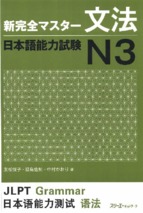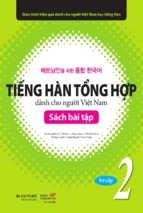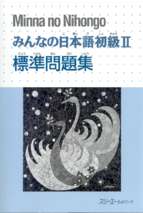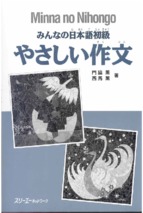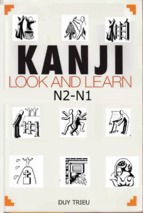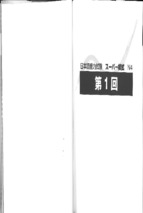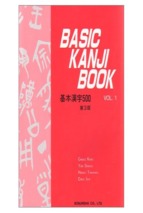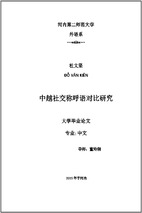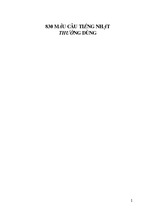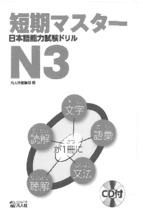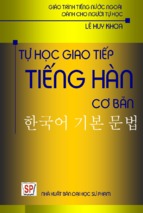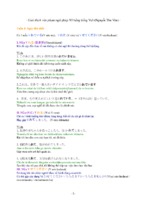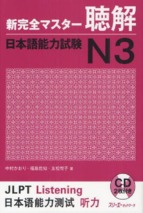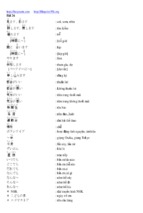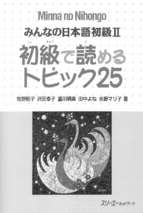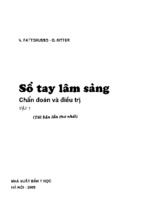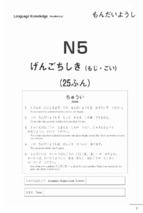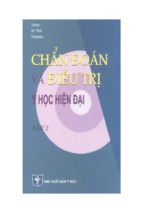Khẩu ngữ tiếng hàn, tiếng hàn giao tiếp 1 cách tự nhiên như người bản ngữ, các bạn hãy tham khảo
GET D!RTY
BAEK
Next time you’re traveling or just chattin’
in Korean with your friends, drop the
textbook formality and bust out with
expressions they never teach you in
school, including:
◆ cool
slang
◆ funny insults
◆ explicit sex terms
◆ raw swear words
What’s up?
Holy shit, I’m trashed.
I gotta piss.
Who farted?
Wanna try doggy-style?
That bitch is crazy!
I could go for some Korean BBQ.
왔냐?
Ulysses Press
$10.00 U.S.
Distributed by
Publishers Group West
Wasseo?
Ssibal, na manchiwi.
Na swi ssayahae.
Bangu nuga ggyeosseo?
Dwichigi haeboja?
Jeo nyeon michin nyeoniya!
Na cheolpangui meokgospieo.
KOREAN
Everyday Slang from
“What’s Up?” to “F*%# Off!”
KOREAN
Dirty Korean teaches the casual expressions heard
every day on the streets of Korea:
D!RTY
Ulysses
Press
꺼져!
HAEWON GEEBI BAEK
Dirty
Korean
Dirty
korean
EVERYDA Y S L A N G F R O M
“WHAT’S UP?” TO “F*%# OFF!”
∏∏∏∏∏�Haewon Geebi Baek
Illustrated by Lindsay Mack
Ulysses Press
Text Copyright © 2010 Haewon Baek. Design and concept
© 2010 Ulysses Press. Illustrations © 2010 Lindsay Mack. All
rights reserved, including the right to reproduce this book or
portions thereof in any form whatsoever, except for use by a
reviewer in connection with a review.
Published by:
Ulysses Press
P.O. Box 3440
Berkeley, CA 94703
www.ulyssespress.com
ISBN: 978-1-56975-779-6
Library of Congress Control Number: 2009940343
Printed in Canada by Webcom
10 9 8 7 6 5 4 3 2 1
Acquisitions editor: Kelly Reed
Managing editor: Claire Chun
Editors: Nick Denton-Brown, J. Han
Production: Abigail Reser
Proofreader: Lauren Harrison
Interior design: what!design @ whatweb.com
Cover design: Double R Design
Front cover photo: woman © bigstockphoto.com/WizData
Back cover illustration: Lindsay Mack
Distributed by Publishers Group West
This book is dedicated, of course, to my one and only
sis, 혜진언니
Table of
Contents
Using This Book
1
[1] Howdy Korean
6
[2] Friendly Korean
19
[3] Party Korean
37
[4] Body Korean
57
[5] Horny Korean
76
[6] Angry Korean
95
[7] Poppy Korean
110
[8] Sporty Korean
127
[9] Hungry Korean
145
About the Author
165
•••••Acknowledgments
I would like to thank acquisitions editor Kelly Reed for giving
me the opportunity to write this book. I could not have finished
this project without her words of encouragement during my
bouts of writer’s block and procrastination. I also want to thank
two exchange students from Korea, Gyungbae Jeon and
Dong-guen Kim Oppas, who came to my rescue and supplied
some cool new slang terms that I’ve gladly added to the book.
I must thank my parents (I am Korean, albeit a hyphenated
“American,” who still values family and the traditional wisdom
they’ve instilled in me), especially my dad, for his sense of
humor that I’ve enjoyed and embraced over the years. Thanks
to Matt Kent, Gene Desmidt, Miyo Nakamura, Borami Lee,
Krissy McClain, Jeffrey Ezell, Drew Dibble, Analisa Lono and
Lauren Adelman, my best friends, for believing in me.
Most importantly, I’ll be super grateful for the rest of my
life to Jinny Baek, my awesome sister. The knowledge she
gathered during the two years she spent teaching English
in Korea proved to be invaluable. She corrected and refined
my work, which would have been dull and humorless if she
hadn’t spent the time reviewing the manuscript and rewrites.
(You can tell that she’s standing right next to me dictating the
words as I type.)
Last, I thank you, the readers, who are so curious about the
Korean language that you’ve bought this little primer. Yes, you
have the right to learn how to say, “Let’s have sex!” or “Suck
my dick!” in Korean!
ix
USING THIS
BOOK
Whether you’re an exchange-student headed to Korea to
study and broaden your worldview, or a frat bro looking to
drink your ass off and feed your raging case of Yellow Fever,
you’re gonna need to know more than just how to say “hi” and
“thank you.” You need to be able to order a drink, pick up a
date and tell a douchebag to go “suck on your mama’s titties”
more (ssibalnom, gaseo eomma jeot-ina deo bbaldawa;
씨발놈, 가서 엄마 젓이나 더 빨다와)!
This book is designed to teach you all those sorts of words,
the ones that your professors were too scared to teach you,
those phrases too raunchy to appear in any textbook and all
those expressions you would never, ever say in front of your
mother—in short, all the sayings that you actually give a shit
about. Because let’s be honest, when was the last time you
were hanging out with friends and felt the need to say “I live in
the red house. I enjoy tennis. Where is the library?” Nobody
talks this way, least of all Koreans, who—once they warm up
to you—can be some of the most foulmouthed motherfuckers
you’ll ever meet. So let’s get real for a change.
Dirty Korean is the product of a lifetime of vulgar language
picked up from lots of bad company and many a poor life
Using this book
1
choice—none of which I regret today, however, because it all
led to this little gem of a book that I now pass on to you, dear
reader. Use it wisely and at your own peril.
It’s been arranged thematically, and each English phrase is
followed by its Korean pronunciation and written characters.
I’ve also included important and interesting tidbits on Korean
culture to give you a better understanding of the phrases,
places and social customs you’ll encounter during your
travels. That’s because I’d hate to have you mistake a
sarcastic pickup line for a verbal slap-in-the-face and lose
your chance at baggin’ some hottie. So now, go forth—take
your Dirty Korean and get dirty with it!
•••••�Quick and Dirty Korean
Pronunciation
Korean is super easy to read and write once you master the
24 characters that, when put together, make the sounds of
the Korean language. If you’re a quick learner, you’ll probably
master them in about an hour. The letters are all geometric
shapes that were created by King Sejong in the 1400s.
TONES
To most foreigners, Korean just sounds angry or whiny.
Koreans tend to speak with a stiff intonation, as opposed
to the more fluid sounds of English speakers. One way to
practice your Korean accent is to drag your tongue at the end
of your syllables to make the sounds a little whinier (the tilde
after the hangeul means you should drag out the syllable).
Annyeong~
안녕~
2
Dirty korean
CONSONANTS
The Korean alphabet has 14 consonants that are similar to
those in English. However, there are double consonants that
are pronounced differently. Whenever you see doubled letters,
make sure to speak with a strong emphasis that almost make
you sound angry.
ㄱ = g, k, like in “gorgeous” / ㄲ = kk
ㄴ = n, like in “norm”
ㄷ = d, t, like in “drum” / ㄸ = dd, tt
ㄹ = r, l, like in “rude”
ㅁ = m, like in “morning”
ㅂ = �b, p, like in “breasts” / ㅃ = bb like in “pepper”
ㅅ = s, like in “sex”/ㅆ = ss
ㅇ = �ng, like in “meeting” (but silent if at the beginning
of the word)
ㅈ = j, like in “joy”/ㅉ = jj
ㅊ = ch, like in “chihuahua”
ㅋ = k, like in “key”
ㅌ = t, like in “toy”
ㅍ = p, like in “punch”
ㅎ = h, like in “horny”
VOWELS
The Korean dialect has 10 vowels. It can be difficult to
pronounce them at first because of the subtle similarity of
their sounds. But once you get to hang of it, it’s pretty easy.
Using this book
3
HOW TO READ KOREAN]]]
Korean can be written in either the standard Western style (left to right
in horizontal rows) or in vertical columns reading from top to bottom and
right to left, although the latter is rarely used nowadays.
When actually reading the characters, remember that letters (consonants
and vowels) never stand alone—consonants are always combined with a
vowel (or a vowel and another consonant) to form syllable blocks. These
blocks always start with a consonant followed by a vowel to the right of
or beneath it. Note: When the consonantㅇis placed at the beginning of
a block, it’s silent.
You pronounce the sound of each letter in a syllable block from left to
right first, then read any letters that are at the bottom half of the block.
The bottom letters are called batchim (받침), supporting consonants
used at the end of a syllable block to form the sound. For example, 한글
(hangeul). It reads:
ㅎ(h)
ㅏ(a)
ㄴ (n)
ㄱ (g)
ㅡ (eu)
ㄹ (l)
Then try and 쉽다 (swipda) = ㅅ (s), ㅟ (wi), ㅂ (p), ㄷ (d), ㅏ (a).
You just said 한글쉽다, which means “Korean is easy!” The learning’s
gonna be so fast that you’ll be ordering soju and negotiating with a
prostitute in no time!
ㅏ = a, like in “father”
ㅑ = ya, like in “yahoo”
ㅓ = eo, like in “fuck”
ㅕ= yeo, like in “y’all”
ㅗ = oh, like in “old”
ㅛ = yo, like in “yo mama”
ㅜ = u, like in “moon”
4
Dirty korean
ㅠ = yu, like in “you”
ㅡ = �eu, there is no sound like this in English. Just put
your teeth together and pull your lips while you try
to make this vowel sound.
ㅣ = i, like in “lily” or “silly”
Also, Korean vowels combine to make different sounds such
as,
ㅐ (ㅏ + ㅣ) = ae, like in “bayer”
ㅒ (ㅑ + ㅣ) = yae, like in “yeah”
ㅔ (ㅓ + ㅣ) = e, like in “never”
ㅖ (ㅕ + ㅣ) = ye, like in“Yale”
ㅘ (ㅗ + ㅏ) = wa, like in “wash”
ㅙ (ㅗ + ㅐ) = wae, like in“whey”
ㅚ (ㅗ + ㅣ) = oe, also like in “whey”
ㅝ (ㅜ + ㅓ) = wo, like in “woman”
ㅞ (ㅜ + ㅔ) = we, like in “wedding”
ㅟ (ㅜ + ㅣ) = wi, like in “wing”
ㅢ (ㅡ + ㅣ) = ui, like in “ooh-ee”
Using this book
5
CHAPTER 1
Howdy
Korean
HANGUK INSAMAL
한국 인사말
•••••Hello
Annyeonghaseyo
안녕하세요
Unlike some languages, it’s cool to use Korean slang with
complete strangers. But only if you’re older than they are. If
you’re not, or it’s questionable, you best stick to formalities
and old-fashioned “hellos.” Korea is just age-deferential like
that. If you’re with friends though, all bets are off—feel free to
get slangy as you wanna be.
Hi (to same age or younger)
Annyeong
안녕
Yo!
Ya!
야!
6
Dirty korean
Hey!
Imma!
임마!
Good to see ya.
Banga banga.
방가 방가 .
On the phone:
Hello?
Yeoboseyo?
여보세요?
Who dis?
Nuguseyo?
누구세요?
•••••What’s up?
Wannya? / Wasseo?
왔냐? / 왔어?
Like in any language, you always gotta find out how your
peeps been doin’ when you haven’t seen ’em in a while. Don’t
be too surprised, though, when Koreans talk bluntly about
how fat your ass has gotten since they last saw you. Changes
to your physical appearance are considered fair game for
discussion. Don’t be offended. It just is what it is, fatty.
How ya been?
Jal jinaeni?
잘 지내니?
Yeah, I’m good!
Eung, jal jinae!
응, 잘 지내!
Good!
Joa!
좋아!
Howdy Korean
7
So-so.
Geunyang geurae.
그냥 그래.
Sucky.
Guryeo.
구려.
Whatcha been up to?
Mohago sarannya?
뭐하고 살았냐?
Long time no see!
Oretmaniyeyo!
오랫만이예요!
It’s been a while.
Olman!
올만!
You’re still alive?
Saraisseonnya?
살아있었냐?
You need to lose
some weight!
Sal jom bbaeyagetda!
살 좀 빼야겠다!
Your face has gotten
chubbier!
Eolguli tongtonghae!
얼굴이 통통해!
Your mom has gotten
chubbier!
Neone eomma saljom
jjisyeosseo!
너네 엄마 살좀 찌셨어!
8
Dirty korean
•••••Goodbye
Jal jinae~
잘 지내~
You know how in Hawaiian aloha means both “hi” and “bye”?
Well, Korean is the same way. You just have to drag out the
end of the word “hello” to make the difference.
Goodbye (general use)
Annyeong~
안녕~
Goodbye (to a person staying)
Jal isseo~
잘 있어~
Goodbye (to a person leaving)
Jal ga~
잘 가~
Goodbye (when both parties are parting)
Jal jinae~
잘 지내~
Literally, “be well.”
Bye bye
Bai bai
바이 바이
See ya!
Tto boja!
또 보자!
Later!
Najungebwa!
나중에봐!
I’m out.
Na ganda.
나 간다.
Howdy Korean
9
- Xem thêm -


